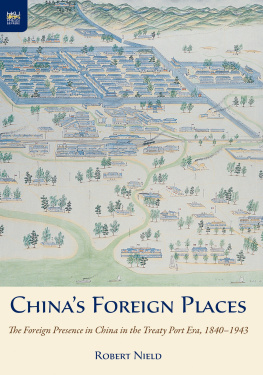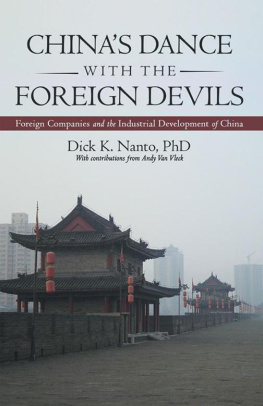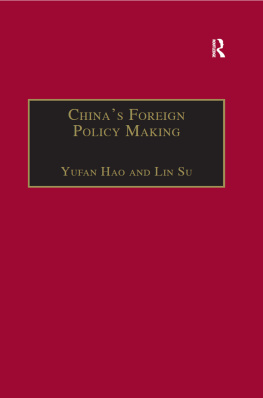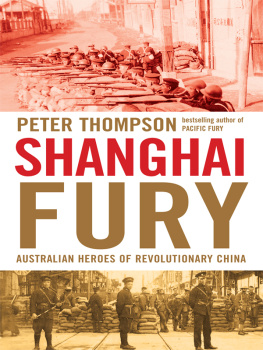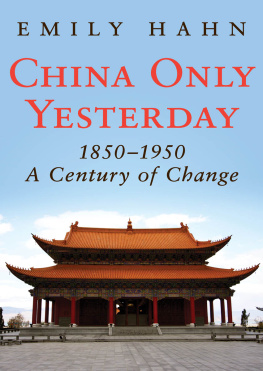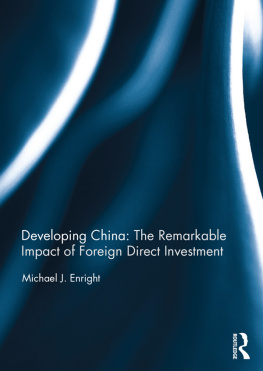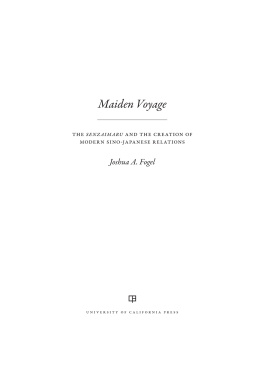Chinas Foreign Places
Chinas Foreign Places
The Foreign Presence in China in the Treaty Port Era, 18401943
Robert Nield

Hong Kong University Press
The University of Hong Kong
Pokfulam Road
Hong Kong
www.hkupress.org
2015 Hong Kong University Press
ISBN 978-988-8139-28-6 (Hardback)
ISBN 978-988-8313-57-0 (eBook)
All rights reserved. No portion of this publication may be reproduced or transmitted in any form or by any means, electronic or mechanical, including photocopy, recording, or any information storage or retrieval system, without prior permission in writing from the publisher.
British Library Cataloguing-in-Publication Data
A catalogue record for this book is available from the British Library.
First printing 2015
First eBook 2015
10 9 8 7 6 5 4 3 2 1
In presenting to the public the following pages, the [writer has] had but one object in viewthat of producing a book of general use for intending visitors to, and residents in, the [country] of which it treats. As the first attempt to embody in a comprehensive and accessible form the various important particulars scattered over the many works upon China... hitherto published, a certain amount of consideration will doubtless be accorded by the public. To have entered fully into the historical details respecting each port which would be necessary to form a work of sufficient completeness to satisfy a student of Eastern policy in these countries, would be obviously beyond the scope of a single volume, nor has such been its object. While not pretending to these claims, there is, it may be hoped, much which will be found new and unknown to the general mass of readers.
From the preface to The Treaty Ports of China and Japan by Mayers, Dennys and King, published in 1867
Preface
This book grew from an interest in the treaty ports of China, an interest that developed into a fascinationand then an obsession. On moving to Hong Kong from England in 1980 I became aware of the very special nature of the city. While being difficult to find on a map of the globe, this tiny place boasted the worlds tenth-largest trading economy. It was an anachronism with little right to such economic status, and yet... In addition to spending all hours of the day contributing to the continuing prosperity of Hong Kong through my work as a public accountant, I started to take an interest in why it was that Hong Kong enjoyed such success; indeed, why it was there at all. Nor was Hong Kong alone in terms of European settlements tacked on to the side of China. All of these are now Chinese towns or cities of varying size but many of them retain a trace, or rather more, of their former foreign occupation.
My initial research focused on the European commercial approaches to China, starting with the Portuguese in the 16th century, then the Dutch in the 17th. The British became dominant in the 18th and 19th centuries, and that dominance led to a conflict that gave rise to not only the colony of Hong Kong but also the first five treaty portsAmoy (Xiamen), Canton (Guangzhou), Foochow (Fuzhou), Ningpo (Ningbo) and Shanghai. I described these six cities, and the historical background to the treaty port system, in my book The China Coast: Trade and the First Treaty Ports, published in 2010. My next step was obviousto describe each of the former treaty ports of China individually in a new book. This was last done in 1867, when Mayers, Dennys and King produced their monumental The Treaty Ports of China and Japan. My update would include not only treaty ports, but the many other foreign commercial settlements in China, large and small.
It has been said that, as they are by definition on the periphery, most written history has treated port cities rather shabbily. Indeed, surprisingly little has been written about a great many of Chinas treaty ports as individual places. Frances Woods No Dogs and Not Many Chinese: Treaty Port Life in China 18431943, published in 1997, provides an admirable, accessible overview. One or two ports have been the subject of comprehensive histories, although some of these are now not easy to find. Examples include O. D. Rasmussens Tientsin: An Illustrated Outline History (1925) and William T. Rowes Hankow: Commerce and Society in a Chinese City, 17961889 (1984). There are excellent volumes on the history and development of Hong Kong and Shanghai. Some books cover one particular issue in the majority of treaty ports without describing many of them in detail, such as P. D. Coatess The China Consuls (1988). References to some of the more obscure ports may be found in the indexes of even more obscure books. My mission was to bring each place to life by providing interesting and concise information not readily available elsewhere. I also wanted to make my entries as complete as possible, using all the sources my detection skills could identify. Only the entries on Hong Kong and Shanghai have been given a different treatment. Their inclusion in the same manner as the others would have created a volume many times the size of this one. Instead, I have provided a concise history of these two cities over the relevant period without attempting to make those histories complete.
Places that served solely as missionary stations have been excluded, firstly because they have been extensively documented elsewhere (for examples, see Cohens China and Christianity [1963] and Carlsons The Foochow Missionaries [1974]); and, secondly, because my chief interest is in commercial activity. What is left is a comprehensive summary of the many Chinese places that at one stage came under foreign administration to a greater or lesser degree during the Treaty Port Era, roughly 1840 to 1943. Most entries start with a brief background history, in order to put the place in context. Similarly, I have assumed some knowledge of events happening on the Chinese and world stages on the part of my readers, so as to concentrate on matters at the local level in each of the places covered. For example, the individual stages of the Second Opium War are not explicated, but the entry on Canton describes that conflict to the extent it had a direct bearing on the city.
Each entry is intended to stand alone (although the option to read the book cover to cover is, of course, available). This requires some degree of repetition, although I have ensured that where this happensthe story of tea, for examplethere is a different yet relevant and complete treatment in each of the entries affected. Continuing the example, I have not attempted to research and write about the subject of tea per se, but I have included the material I found while researching, in this case, Hankow (Hankou) and Foochow. Although there is very little to be said about some of the smallest places covered, the length of each entry does not necessarily reflect its subjects relative importance. Rather, length has tended to be determined by the amount of interesting source material available.
In most cases a separate entry for each of the ports and other places covered has been given. Taku (Dagu), for example, had a history and existence that was independent of Tientsin (Tianjin), its much bigger neighbour. Similarly Hong Kong and Kowloon are treated separately; Kowloon was an extremely important customs station that operated independently of Hong Kong. However, where two or more places were so closely related that separate entries would have been pedantic, I have combined themSwatow (Shantou) and Namoa (Nanao), for example, and Tamsui (Danshui) and Keelung (Jilong). Where there are books that add further information about specific ports I have listed these in a Further reading note at the end of the relevant entry. Furthermore, the Bibliography at the end of the book has been made as comprehensive as possible, to encourage further reading and research and be of use to other scholars.

